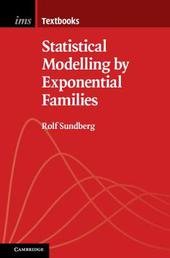
|
Statistical Modelling by Exponential Families
Paperback / softback
Main Details
| Title |
Statistical Modelling by Exponential Families
|
| Authors and Contributors |
By (author) Rolf Sundberg
|
| Series | Institute of Mathematical Statistics Textbooks |
|---|
| Physical Properties |
| Format:Paperback / softback | | Pages:296 | | Dimensions(mm): Height 228,Width 152 |
|
| Category/Genre | Probability and statistics |
|---|
| ISBN/Barcode |
9781108701112
|
| Classifications | Dewey:519.5 |
|---|
| Audience | | Postgraduate, Research & Scholarly | |
|---|
| Illustrations |
Worked examples or Exercises; 22 Line drawings, black and white
|
|
Publishing Details |
| Publisher |
Cambridge University Press
|
| Imprint |
Cambridge University Press
|
| Publication Date |
29 August 2019 |
| Publication Country |
United Kingdom
|
Description
This book is a readable, digestible introduction to exponential families, encompassing statistical models based on the most useful distributions in statistical theory, including the normal, gamma, binomial, Poisson, and negative binomial. Strongly motivated by applications, it presents the essential theory and then demonstrates the theory's practical potential by connecting it with developments in areas like item response analysis, social network models, conditional independence and latent variable structures, and point process models. Extensions to incomplete data models and generalized linear models are also included. In addition, the author gives a concise account of the philosophy of Per Martin-Loef in order to connect statistical modelling with ideas in statistical physics, including Boltzmann's law. Written for graduate students and researchers with a background in basic statistical inference, the book includes a vast set of examples demonstrating models for applications and exercises embedded within the text as well as at the ends of chapters.
Author Biography
Rolf Sundberg is Professor Emeritus of Statistical Science at Stockholms Universitet. His work embraces both theoretical and applied statistics, including principles of statistics, exponential families, regression, chemometrics, stereology, survey sampling inference, molecular biology, and paleoclimatology. In 2003, with M. Linder, he won the award for best theoretical paper in the Journal of Chemometrics for their work on multivariate calibration, and in 2017 he was named Statistician of the Year by the Swedish Statistical Society.
Reviews'Rolf Sundberg's book gives attractive properties of the exponential family and illustrates them for a wide variety of applications. Definitions are concise and most propositions look directly appealing. The writing reflects the author's experience in deriving results that are essential for good modelling and convincing inference. Thus, this book is indispensable for all data scientists, be they graduate students or experienced researchers.' Nanny Wermuth, Chalmers tekniska hoegskola, Sweden 'This is an excellent book on exponential families. It covers not only the basic properties of exponential families but also several modern topics such as graphical models and random networks. The author blends theories and applications elegantly and provides several useful examples from various scientific domains. It is suitable for a one-semester graduate-level course and will be an excellent reference for topic courses such as stochastic modeling and parametric models.' Yen-Chi Chen, Journal of the American Statistical Association 'Overall, this is a clearly written, graduate-level introduction to an important area of statistical modelling. The numerous examples and exercises included throughout provide invaluable illustrations across a number of application areas, making this a useful reference for both researchers and practitioners. As a textbook, it is an excellent starting point for either a taught course on statistical inference with an emphasis on data from the exponential family, or for self-directed study in this area.' Fraser Daly, Institute of Mathematical Statistics Textbooks 'This book is perfect for an introductory theoretical graduate course but its parts could also definitely be used in a more applied course. The only prerequisite is basic mathematical statistics. The book is also very handy as a general reference on exponential families. To keep the content simple, the author sometimes avoids the most technical details; however, all necessary references are provided for the reader's convenience. In this sense the book can be used by any researcher interested in exponential families from either a more theoretical or more applied point of view.' Piotr Zwiernik, MathSciNet
|